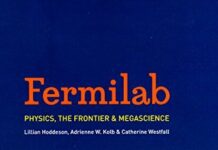
Ebook Info
- Published: 1997
- Number of pages: 714 pages
- Format: PDF
- File Size: 34.25 MB
- Authors: Lillian Hoddeson
Description
Based on a conference held at Stanford University, this book gives the most comprehensive and up-to-date account of an exciting physics revolution–the rise of the Standard Model. The third volume of a series recounting the history of particle physics, this volume focuses on the Standard Model, which explains the microstructure of the world in terms of quarks and leptons and their interactions. Major contributors include Steven Weinberg, Murray Gell-Mann, Michael Redhead, Silvan Schweber, Leon Lederman, and John Heilbron. A collaboration of physicists and historians of science, the wide-ranging articles explore the detailed scientific experiments, the institutional settings in which they took place, and the ways in which the many details of the puzzle fit together to account for the Standard Model.
User’s Reviews
Editorial Reviews: Review ‘… a beautifully produced collection of essays by most of the leading scientists involved – including no fewer than eight Nobel laureates – and several eminent historians … both practitioners and knowledgeable bystanders can draw inspiration from these reflections on what may turn out to have been the golden age of particle physics.’ Graham Farmelo, New Scientist’The volume is informative and useful to historians of physics.’ Helge Kragh, Centaurus’… this book is … worthwhile , timely and valuable.’ R. Barlow, European Journal of Physics Book Description This volume explores the rise of the Standard Model in modern particle physics.
Reviews from Amazon users which were colected at the time this book was published on the website:
⭐Not only is this book “useful to historians,” as Kragh writes, it is valuable for practicing physicists. Swelling at well over seven-hundred pages, I must regrettably constrain and restrain myself in this review (forsaking detail). Six pages of photographs and an excellent index enhance the efficacy of the book as reference. Each essay concludes with its own section of notes and bibliographic references. Demarcated into seven parts, the book is a veritable ‘Who’s Who’ of particle physics, a few luminaries:(1) Introduction (Brown, Weinberg, Heilbron).(2) Quarks and Leptons (Goldhaber, Perl,Lederman, Cronin, Kobayashi).(3) Toward Gauge Theories (Veltman, ‘tHooft, Gross, Susskind, Polyakov, Shirkov).(4) Accelerators, Detectors and Laboratories (Richter, Johnsen, Schwitters, Galison, Wilson, Kolb, Westfall ).(5) Electroweak Unification (Bludman, Schwartz, Perkins, Iliopoulos, Prescott, Nambu ).(6) Discovery of Quarks and Gluons (Smios,Lipkin,Morpurgo,Friedman,Bjorken,Wu).(7) Personal Overviews (Gell-Mann, Teller, Redhead, Schweber).Words from a few participants of this Conference (Third International Symposium History Particle Physics):(1) Brown: “…this work (of Yang and Mills) caught the imagination of some theorists, but…physicists generally ignored it for years.” (page 5, Introduction: The Rise of the Standard Model).(2) Steven Weinberg: “most of us were skeptical about the Quark model.” (page 37, Changing Attitudes and the Standard Model).(3) Leon Lederman: “…it’s important to emphasize, this story is one of missed opportunities, abysmal judgement, monumental blunders, stupid mistakes, and inoperative equipment.” (page 101, Discovery of Upsilon, Bottom Quark and B-Mesons).(4) Martinus Veltman: “People (at least most) did not go into Yang-Mills theories after Glashow’s, Weinberg’s, or my paper. The proof of renormalizability provided the necessary psychological impact.” (page 173, The Path To Renormalizability).(5) Brout: “It took a great deal of fortitude in those days to construct a field theory.” (page 496, Comments regarding Spontaneously Broken Symmetry).(6) Perkins : “until 1971, there seemed also to be little conviction about the electroweak models in the bulk of the physics community.” (Gargamelle and the Discovery of Neutral Currents)(7) Peter Higgs commentary: “The speed of my reaction owed a lot to the influence of Schwinger, whose papers on gauge invariance and mass I had been following with interest.” (page 507, Spontaneous Breaking of Symmetry and Gauge Theories).(8) Two essays were less than compelling: Teller, The Philosopher’s Problem and Redhead,Should We Believe in Quarks and QCD ?(9) The most technical essay by ‘t Hooft, Renormalization of Gauge Theories. As expected, it is a masterful exposition. The panel session on Spontaneous Breaking of Symmetry (pages 478-522) is truly a tour de force. Charts, experimental data, experimental facilities, personal notebooks and recollections, provide for a goldmine of thought.(10) In conclusion: This book, along with Abraham Pais’ Inward Bound (Oxford,1986), provides insight and perspective on the history, progress and development of particle physics.Highly recommended !
⭐While the essays perhaps strive to reach a wide audience, the reality is that the typical reader will likely be a physicist or student of science history. If this fits your background, then the book is indeed an informative account of how the so-called Standard Model arose.Much of the book’s value is that several authors were key participants in the development of the Standard Model. Foremost might be Murray Gell-Mann. But let’s not forget Weinberg and Lederman. Future historians can see here in the words of these men how pivotal ideas arose and gelled into an overarching and still dominant framework unifying much of physics.We also see how the expensive particle accelerators proved their worth. (At least to physicists!) In providing experimental evidence of particles predicted or explained by the Standard Model.
⭐Si tratta di un testo fondamentale per chi è interessato a conoscere la storia della fisica delle particelle fra gli anni 60 e 70. Dallo “zoo” di particelle alla nascita della teoria del Modello Standard, esprimenti, previsioni teoriche, scoperte, il tutto raccontato tramite saggi dei diretti protagonisti.Forse un punto di vista troppo americano e poco europeo, visto che a scrivere sono soprattutto scienziati statunitensi.Il libro è arrivato in soli 3 giorni ed in condizioni assolutamente perfette.
⭐
⭐
⭐
Keywords
Free Download The Rise of the Standard Model: Particle Physics in the 1960’s and 1970’s 1st Edition in PDF format
The Rise of the Standard Model: Particle Physics in the 1960’s and 1970’s 1st Edition PDF Free Download
Download The Rise of the Standard Model: Particle Physics in the 1960’s and 1970’s 1st Edition 1997 PDF Free
The Rise of the Standard Model: Particle Physics in the 1960’s and 1970’s 1st Edition 1997 PDF Free Download
Download The Rise of the Standard Model: Particle Physics in the 1960’s and 1970’s 1st Edition PDF
Free Download Ebook The Rise of the Standard Model: Particle Physics in the 1960’s and 1970’s 1st Edition


